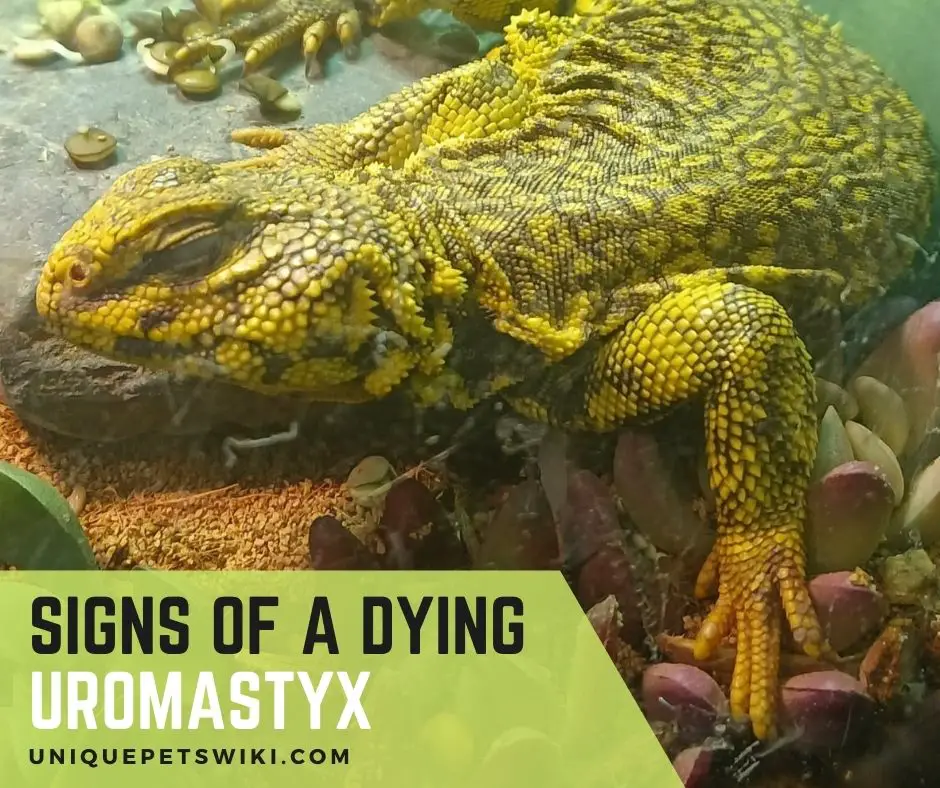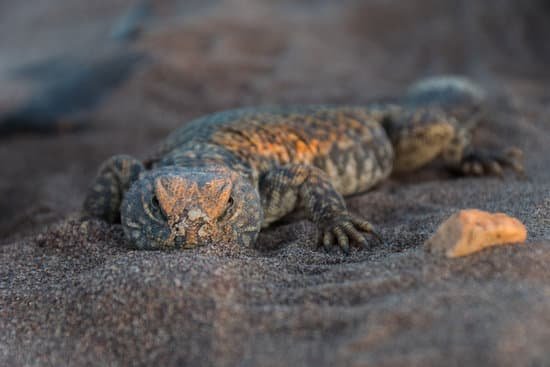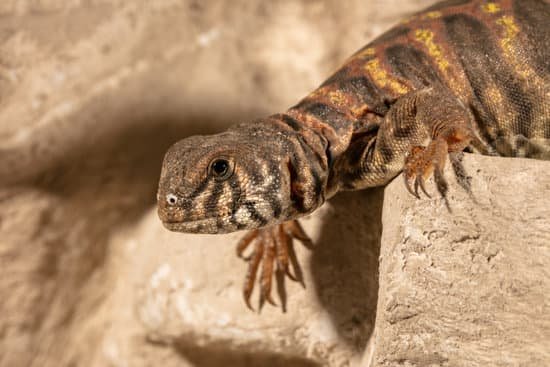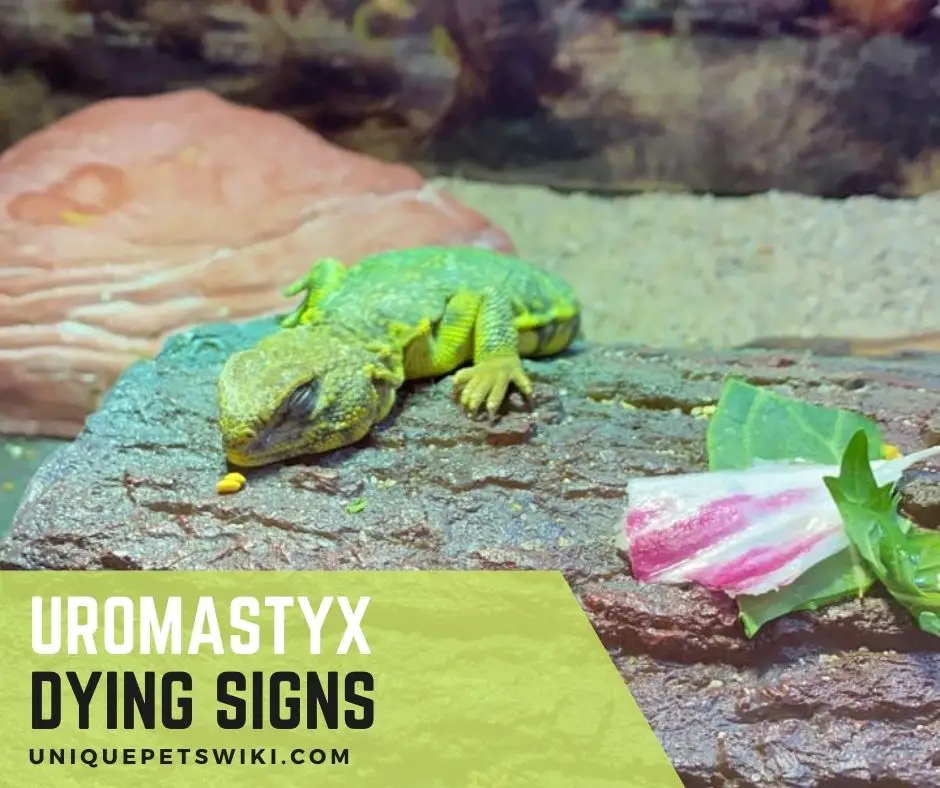Nowadays, Uromastyx lizards are getting more popular as beginner pets because of their ease of care. Uromastyx lizards are hardy lizards and have a long lifespan if you can prepare proper care and a good home for them.
However, many people do not have the right knowledge about how to take care of their lizards. Some beginner hobbyists also cannot determine if their uromastyx is showing signs of ailment and how to detect if their lizard is dying.
In this article, we will highlight how you can detect the numerous uromastyx dying signs and how you can treat your sick uromastyx lizards at home.
This article has been reviewed by Dr. Gospel. Read more about our knowledge control process here.
Contents
08 Signs Of A Dying Uromastyx

You should note that uromastyx lizards are hardy lizards and rarely have health issues.
However, uromastyx lizards can get sick if you do not provide them with the right attention and care. Uromastyx lizards have slow metabolisms and they don’t usually show signs of illness until it is too late to treat.
Some of the signs that you can be on the lookout for to determine if your uromastyx is dying are stated below.
- Lethargy
- Weight loss
- Sunken eyes
- Runny poop
- Black digits or tail tip
- Bloated belly
- Limping
- Tail kinking, hanging or soft jaw, swollen limbs, etc.
- Discolored skin
Most of the common health problems that can happen to uromastyx can be easily prevented with proper husbandry.
Furthermore, you should ensure that you feed your lizard with the correct diet.
You should always be prepared to take your uromastyx to the vet whenever they are visibly sick.
How To Tell If Your Uromastyx Lizards Are Sick?
Uromastyx lizards can carry a health issue for a long time before you even detect that it is sick. This is because reptiles are very good at masking health problems. Furthermore, in the wild, weak uromastyx usually get taken out by predators or get exiled from the group.
This is why it is important that you spend time with your uromastyx to help detect what is its normal behavior. You can then easily detect if your lizard is sick once there are changes in your pet lizard’s behavior.
There are several ways that you can use to detect if your uromastyx is sick and some of them are stated below.
Lack Of Appetite
Lizards generally love to eat. This is why the most obvious way to detect if your uromastyx lizard is sick is loss of appetite. Furthermore, once you notice it, you should ensure that you don’t ignore it.

Uromastyx lizards are omnivorous and can eat a varied diet of plants and insects (baby uros). However, once you notice that your uromastyx are not interested in the foods you put in their tank for a few days, you should take it to the vet as soon as possible.
Clarification: Adult uromastyx should not eat insects. Thanks to my friend E.Weber
Fewer Droppings
Your uromastyx lizard’s stool comprises two parts, a white part that is made up of uric acid and a brown section made up of stool.
Fewer dropping usually means that your uromastyx eats less food.
This is why you should pay extra attention to your pet’s appetite once you notice there are fewer droppings in the tank.
Once you notice this, you should try to take your uromastyx to the vet for a checkup.
Lethargy
Healthy uromastyx are usually bright-eyed and active while moving around their tank or basking in the sunlight.
They usually respond to things that they see and are usually alert. However, sick uromastyx will stay stationary for hours or hide under their bedding or objects in the tank.
Furthermore, it may be too weak to push up its belly on its legs causing it to slither around on its belly like snakes.
Once you discover this type of behavior or notice weakness in your uromastyx, you should get your uromastyx checked out by the vet.
Sunken Eyes
A healthy uromastyx generally have wide-open eyes, supple skin, and moist gums.
However, once you notice that your uromastyx have sunken eyes or retained shedding, then there is a probability that it is dehydrated. This is because uromastyx absorb water through the food they eat and through their skin when you mist or soak them.
This means your uromastyx will be dehydrated if they are not getting enough moisture from their food or there is low humidity in their tank which makes them lose their moisture content. You can take your lizard to the vet to help determine the underlying cause of the dehydration.
Weight Loss
This is not usually an obvious sign in uromastyx and you can only notice this when your lizard has lost a significant amount of weight. Some of the body changes that can help you detect weight loss are thinning of the tail and prominence of the ribs.
Furthermore, by the time you start noticing weight loss signs in uromastyx lizards, it may be too late. Since the illness that causes the fat loss has advanced, and it has become too weak to fight it off.
It is best to take your uromastyx to the vet immediately to determine the cause of weight loss. Then, start nutritional supplementation to take the pet back to a more appropriate weight.
Can You Treat A Sick Uromastyx?

You can treat a sick uromastyx if the sickness has not progressed to the point where it cannot be reversed. The first thing to do to treat a sick uromastyx is by providing an ideal living condition for it. Their tank should always be clean and the temperature and humidity should be at an optimum level.
You should also ensure that you remove old food matter, dirty bedding, and fecal waste daily. This will help you to prevent the spread of bacteria and viruses that can make your lizard sick. Furthermore, ensure you provide your uromastyx with access to clean and fresh water.
This is because dehydration is a major cause of ailments with reptiles. Furthermore, just rehydrating your uromastyx may help you to reverse its ailing condition. However, ensure that you get your uromastyx checked regularly by a vet that specializes in reptiles to help detect the exact cause of their problem.
The Ill Symptoms That You Can Treat At Home
There are some uromastyx ailments that you can easily treat at home. However, it is best if you consult a herp vet to advise you on the best way to treat your uromastyx at home.
Uromastyx White-Nose
You should not worry if you discover white powder on the nose of your uros. The white powder is also called snalt and it is a way used by uromastyx to excrete excess salts from their body. Uromastyx lizards possess a nasal gland that helps in removing salts from their body without straining their kidneys.
You can simply wipe off any snalt that you notice. However, if there is too much snalting, you can reduce the amount of food that is causing this.
Dehydration In Uromastyx
A dehydrated uromastyx will find it hard to eat and digest food properly. There are several reasons why your uromastyx can become dehydrated such as stress, high temperature in their tank, being shipped for a long period of time, and lack of moisture in their diet.
Some of the signs of a dehydrated uromastyx are
- It will be inactive
- It will look inactive
- It has wrinkly skin
- It has sunken eyes
- The urates in your uromastyx poop will be small or even missing.
The first thing to do when your uromastyx is dehydrated is to review their living conditions. You need to ensure the temperature in its enclosure is not too low or high, and there is a temperature gradient to aid cooling down. You will then need to hydrate your uromastyx as soon as possible.
You can get your uromastyx hydrated by leaving shallow dishwater in their enclosure. You should only offer your uromastyx greens and vegetables and avoid high protein foods like legumes. You can also soak your uromastyx once in 2 days in warm water or mist their tank.
Impaction
This is a health issue where undigested food forms a mass in the digestive system of your uromastyx causing an impaction. Some of the signs of impaction in uromastyx are stated below
- Bloated belly
- Lethargy
- Your uromastyx is unable to poop
- Your uromastyx pass thin poop or the poop has blood because of injury or scratches to the intestines.
You can treat your uromastyx by soaking them in warm water. However, if your uromastyx is unable to poop then you may need to take it to a vet as impactions can lead to death if it is not treated quickly.
You can prevent impaction by maintaining good husbandry and making sure that your uromastyx foods have a high moisture content and it is free from dirt and debris. You should also avoid using improper substrates as it can cause impaction if your uromastyx ingest them.
Metabolic Bone Disease In Uromastyx
Metabolic bone disease is usually caused by calcium deficiency and lack of vitamin D3 in the Uromastyx diet. Furthermore, a diet with high phosphorus levels, and feeding too many oxalic foods can also lead to metabolic bone disease.
Some of the signs of metabolic bone disease in uromastyx lizards are:
- Swollen limbs
- Inability to move legs
- Lethargy
- Deformed back or limbs
- Soft or hanging jaw
You can prevent MBD in uromastyx lizards by providing a high output 10-14% UVB source in the tank. This will help uromastyx to provide Vitamin D3 to the skin. Furthermore, you should offer high calcium staple foods always and avoid feeding your uromastyx with very high phosphorus foods such as corn.
However, if you notice that your uromastyx is suffering from MBD, ensure you get it checked by the vet immediately. Your vet will then carry out blood tests and other examinations to detect how severe the illness is. Furthermore, the vet may need to save your uromastyx by injections if the situation is severe.
Injuries And Burns In Uromastyx
Uromastyx lizards are curious animals and love digging and climbing. One of the things to do as a responsible pet owner is to help your lizard avoid injuries. This can be achieved by taking out any high structures in their tank and removing any sharp objects as well.
You also need to ensure that your uromastyx does not get in contact with light bulbs.
Although uromastyx need high heat lamps, the heat lamps can burn them easily. It is best if you can cover the bulb with a light guard if you plan to place the bulb inside their enclosure.
You can treat burn wounds by applying burn ointment to the wound. Furthermore, you don’t have to cover the wound, but you should ensure that your uromastyx tank is clean until it has healed. You may also need to apply antibiotic ointment to help prevent infection.
When do You Need A VET?
Generally, most of the illnesses that can occur to uromastyx lizards are usually caused by poor living conditions such as lack of sufficient heat, dirty tanks, humidity, light, and food. By observing your uromastyx lizards carefully, you are going to notice many changes in their behavior when sick.
Once you notice any of these signs stated above, you should take them to the vet as soon as possible.
Note: Not all vets treat reptiles. It is best to look for a herp vet that can help make a proper diagnosis and will discover whatever is wrong with your uros. When you are with the vet, always provide enough details about your pet from its living conditions to feeding habits.
This will help the vet to easily detect the cause of the ailment. Furthermore, you should always consult with your vet even when you are treating your uromastyx at home. This is because what you think is a mild ailment may be a major underlying issue.
How To Help Prevent Sickness In Uromastyx
Some of the ways that you can prevent sickness in uromastyx are stated below.
- Always clean your uromastyx tank.
- Provide your uromastyx with proper nutrition.
- Always buy your pet food from a trusted source.
- Proper hygiene when handling or petting your uros.
- Quarantine your uromastyx to avoid the spread of disease
- Provide proper humidity and shedding care.
Wrapping Up
Although uromastyx lizards are hardy animals, they may suffer from several health conditions.
However, most health issues in uromastyx are caused by stress, shipment, and long-term poor husbandry practices.
Once you notice any dying signs in your uromastyx, it is best to take it to the vet immediately.
References:
- Uromastyx forum: https://www.facebook.com/groups/396395070428291/

A Uromastyx Is not an omnivore! Eating insects taxes their liver and kidneys and will cause damage. You should not post inaccurate and harmful information saying you should feed them insects! Due your research as this was clearly not written by a Veterinarian or anyone with proper husbandry skills for a uromastyx.
Hi, sorry for making you concern. Baby uros are omnivore, they do eat insects. I will update the article to highlight that. Thank you for your feedback.